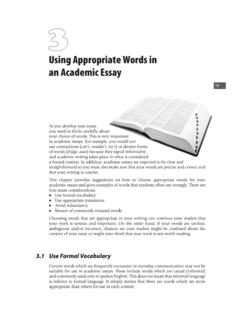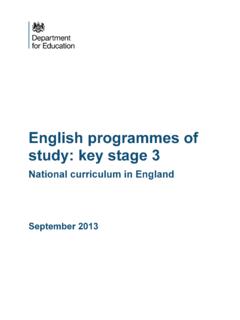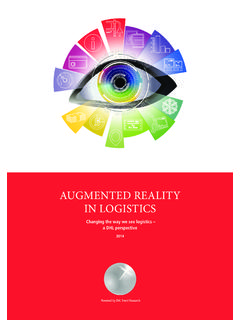Transcription of READING LITERARY (RL) READING INFORMATIONAL (RI)
1 7th Grade English Language Arts Georgia Standards of Excellence (ELA GSE) Georgia Department of Education April 15, 2015 Page 1 of 5 READING LITERARY (RL) READING INFORMATIONAL (RI) Key Ideas and Details Key Ideas and Details ELAGSE7RL1: Cite several pieces of textual evidence to support analysis of what the text says explicitly as well as inferences drawn from the text. ELAGSE7RI1: Cite several pieces of textual evidence to support analysis of what the text says explicitly as well as inferences drawn from the text. ELAGSE7RL2: Determine a theme and/or central idea of a text and analyze its development over the course of the text; provide an objective summary of the text. ELAGSE7RI2: Determine two or more central ideas in a text and analyze their development over the course of the text; pr ovide an objective su mmary of the text. ELAGSE7RL3: Analyze how particular elements of a story or drama interact ( , how se ttings shape the characters or plot).
2 ELAGSE7RI3: Analyze the interactions between individuals, events, and ideas in a text ( , how ideas influence individuals or events, or how individuals influence ideas or events). Craft and Structure Craft and Structure ELAGSE7RL4: Determine the meaning of words and phrases as they are used in a text, including figurative and connotative meanings; analyze the impact of rhymes and other repetitions of sounds ( , alliteration) on a specific verse or stanza of a poem or section of a story or drama. ELAGSE7RI4: Determine the meaning of words and phrases as they are used in a text, including figurative, connotative, and technical meanings; analyze the impact of a specific word choice on meaning and tone. ELAGSE7RL5: Analyze how a drama s or poem s form or structure ( , soliloquy, sonnet) contri butes to its meaning. ELAGSE7RI5: Analyze the structure an author uses to organize a text, including how the major sections contribute to the whole and to the development of the ideas.
3 ELAGSE7RL6: Analyze how an author develops and contrasts the points of view of different characters or narrators in a text. ELAGSE7RI6: Determine an author s point of view or purpose in a text and analyze how the author distinguishes his or her position from that of others. Integration of Knowledge and Ideas Integration of Knowledge and Ideas ELAGSE7RL7: Compare and contrast a written story, drama, or poem to its audio, filmed, staged, or multimedia version, analyzing the effects of techniques unique to each medium ( , lighting, sound, color, or camera focus and angles in a film). ELAGSE7RI7: Compare and contrast a text to an audio, video, or multimedia version of the text, analyzing each medium s portrayal of the subject ( , how the delivery of a speech affects the impact of the words ). ELAGSE7RL8: (Not applicable to literature) ELAGSE7RI8: Trace and evaluate the argument and specific claims in a text, assessing whether the reasoning is sound and the evidence is relevant and sufficient to support the claims.
4 ELAGSE7RL9: Compare and contrast a fictional portrayal of a time, place, or character and a historical account of the same period as a means or understanding how authors of fiction use or alter history. ELAGSE7RI9: Analyze how two or more authors writing about the same topic shape their presentations of key information by emphasizing the different evidence or advancing different interpretations of facts. Range of READING and Level of Text Complexity Range of READING and Level of Text Complexity ELAGSE7RL10: By the end of the year, read and comprehend literature, including stories, dramas, and poems, in the grades 6-8 text complexity band proficiently, with scaffolding as needed at the high end of the range. ELAGSE7RI10: By the end of the year, read and comprehend LITERARY nonfiction in the grades 6-8 text complexity band proficiently, with scaffolding as needed at the high end of the range. 7th Grade English Language Arts Georgia Standards of Excellence (ELA GSE) Georgia Department of Education April 15, 2015 Page 2 of 5 Text Types and Purposes ELAGSE7W1: Write arguments to support claims with clear reasons and relevant evidence.
5 WRITING (W) a. Introduce claim(s), acknowledge alternate or opposing claims, and organize the reasons and evidence logically. b. Support claim(s) with logical reasoning and relevant evidence, using accurate, credible sources and demonstrating an understanding of the topic or text. c. Use words , phrases, and clauses to create cohesion and clarify the rela tionships among claim(s), reasons, and evi dence. d. Establi sh and maintain a formal style . e. Provi de a concluding statement or section that foll ows from and supports the argument presented. ELAGSE7W2: Write informative/expla natory texts to examine a topic and convey ideas, concepts, and information through the selection, organization, and analysis of relevant content. a. Introduce a topic clearly, previewing what is to foll ow; organize ideas, concepts, and information, using strategies such as definition, cla ssification, comparis on/contrast, and cause/effect; include formatting ( , headings), graphics ( , charts, tables), and multimedia when useful to aiding comprehension.
6 B. Develop the topic with relevant facts, definitions, concrete details, quotations, or other information and examples. c. Use appropriate transitions to create cohesion and clarify the relationships among ideas and concepts. d. Use precise la nguage and domain-specific vocabulary to inform about or explain the topic. e. Establi sh and maintain a formal style . f. Provi de a concluding statement or section that foll ows from and supports the information or explanation presented. ELAGSE7W3: Write narratives to develop real or imagined experiences or events using effective technique, relevant descriptive details, and well -structured event sequences. a. Engage and orient the reader by establishing a context and point of view and introducing a narrator and/or characters; organize an event sequence that unfolds naturally and logically. b. Use narrative techniques, such as dialogue, pacing, and descrip tion, to develop experiences, events, and/or characters.
7 C. Use a varie ty of transition words , phrases, and cla uses to convey sequence and signal shifts from one time frame or setting to another. d. Use precise words and phrases, relevant descriptive details, and sensory language to capture the action and convey experiences and events. e. Provi de a conclusion that foll ows from and reflects on the narrated experiences or events. Producti on and Di stribution of Writing ELAGSE7W4: Produce clear and coherent writing in which the development, organization, and style are appropriate to task, purpose, and audience. (Grade-specific expectations for writing types are defined in standards 1 3 above.) ELAGSE7W5: With some guidance and support from peers and adults, develop and strengthen writing as needed by pla nning, revising, edit ing, rewriting, or tryin g a new approach, focusing on how well purpose and audience have been addressed. (Edit ing for conventions should demonstrate command of Language standards 1 3 up to and including grade7.)
8 ELAGSE7W6: Use technology, including the Internet, to produce and publi sh writing and li nk to and cite sources as well as to interact and collaborate with others, including linking to and cit ing sources. Research to Bui ld and Present Knowledge ELAGSE7W7: Conduct short research projects to answer a question, drawing on several sources and generating additional related, focused questions for further research and investigation. ELAGSE7W8: Gather relevant information from multip le print and digital sources, using search terms effectively; assess the credibility and accuracy of each source; and quote or paraphrase the data and conclusions of others while avoiding plagiarism and foll owing a standard format for citation. ELAGSE7W9: Draw evi dence from LITERARY or in formational texts to support analysis, r eflection, and research. a. Apply grade 7 READING standards to literature ( , Compare and contrast a fictional portrayal of a time, place, or character and a historical account of the same period as a means of understanding how authors of fiction use or alter history ).
9 B. Apply grade 7 READING standards to LITERARY nonfiction ( Trace and evaluate the argument and specific claims in a text, assessing whether the reasoning is sound and the evidence is relevant and suffi cient to support the claims ). Range of Writing ELAGSE7W10: Write routinely over extended time frames (time for research, reflection, and revi sion) and shorter time frames (a single sitting or a day or two) for a range of dis cipline-specific tasks, purposes, and audiences. 7th Grade English Language Arts Georgia Standards of Excellence (ELA GSE) Georgia Department of Education April 15, 2015 Page 3 of 5 Comprehension and Collaboration SPEAKING AND LISTENING (SL) ELAGSE7SL1: Engage effectively in a range of collaborative discussions (one-on-one, in groups, and teacher-led) with diverse partners on grade 7 topics, texts, and issues, building on others ideas and expressing their own clearly. a. Come to discussions prepared, having read or researched material under study; explicitly draw on that preparation by referring to evidence on the topic, text, or issue to probe and reflect on ideas under discussion.
10 B. Follow rules for collegial discussions, track progress toward specific goals and deadlines, and define individual roles as needed. c. Pose questions that elicit elaboration and respond to others questions and comments with relevant observations and ideas that bring the discussion back on topic as needed. d. Acknowledge new information expressed by others and, when warranted, modify their own views and understanding. ELAGSE7SL2: Analyze the main ideas and supporting details presented in diverse media and formats ( , visually, quantitatively, orally) and explain how the ideas clarify a topic, text, or issue under study. ELAGSE7SL3: Delineate a speaker s argument and specific claims, evaluating the soundness of the reasoning and the relevance and sufficiency of the evidence. Presentation of Knowledge and Ideas ELAGSE7SL4: Present claims and findings, emphasizing salient points in a focused, coherent manner with pertinent descriptions, facts, details, and examples; use appropriate eye contact, adequate volume, and clear pronunciation.














